8 Turtles That Stay Small
Small Turtles are the preferred type of pet for most people. Small pet turtles require less space. Setting up an aquarium or terrarium (in the case of box turtles) for turtles that stay small is simple and stress-free.
Keeping the water in a small turtle aquarium clean is also easier. There are a lot of small turtles that can be found in the wild and at pet shops. Remember to never pick up a turtle in the wild. We always advocate to buy from captive bred breeders. They just make for better pets.
Popular small turtle species include the diamondback terrapin, red-eared sliders, map turtles (including false map turtle, northern map turtle, and many others), mud turtles, musk turtles, and box turtles. In this article, we will look at some of the most popular miniature turtles.
These turtles listed above, with the exception of the box turtle are all aquatic species that will require tanks to be set up, alternatively you could create an indoor turtle pond for a more natural feel. If you are looking for land turtles, also known as tortoises, be sure to check out our list of small tortoises.
Table of Contents
- Red-Eared Slider
- Map Turtles
- Painted Turtle
- Musk Turtle
- Mud Turtle
- Diamondback Terrapin
- Box Turtle
- Why You Should Choose Turtles That Stay Small
- Why Getting Small Turtles From The Wild Isn’t A Good Idea
- Other Small Turtle Species
Small Turtle Species
1. Red-Eared Slider
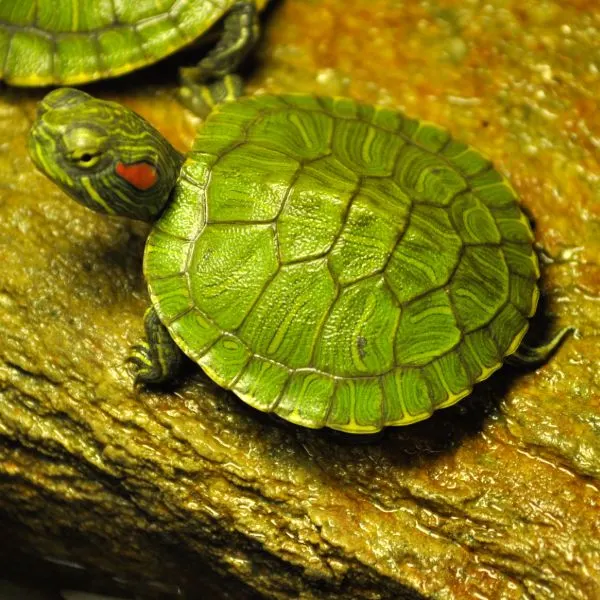
Quick Facts
- Experience Level: Beginner
- Family: Emydidae
- Scientific Name: Trachemys scripta elegans
- Other Common Names: Red-eared terrapin, red-eared slider turtle, red-eared turtle, slider turtle, and water slider turtle
- Average Adult Size: 6 – 12 inches
- Lifespan: 20 – 40 years
- Average Price Range: $20 – $50
Quick Care Requirements
- Diet: Commercial turtle pellets & dark leafy green vegetables
- UVB Lighting: Required
- Tank Size: 40 gallons
- Water Temperature: 75 – 85 °F
- Basking Spot Temperature: 90 – 95°F
The red-eared slider is one of the quarter turtles endemic to North America and is widely loved. They are popular for the red marks on either side of their head around their ears, thus their name – red-eared slider.
These small water turtles grow to be between 6 to 12 inches with females being much bigger. With proper care, the red-eared slider can grow to be 20 to 40 years.
If you want to check the sex of your turtle check out this guide on turtle gender identification.
Red-eared sliders are omnivorous, although adults tend to be more herbivorous. They accept freeze-dried krill, commercial turtle diets such as Mazuri aquatic turtle diet, edible aquatic plants such as water lettuce, duckweed, and anacharis, leafy vegetables such as collard green, flowers, dandelion, and other sliced vegetables such as squash.
House them in a large aquarium and provide a basking spot under a heat lamp. Also, provide UV light.
Red-eared sliders as with most semi-aquatic turtles bask frequently, are strong swimmers, and dislike frequent handling.
It should be noted that a Yellow bellied slider is very similar. When choosing one as a pet, be sure to pick a male. Females will grow to a much larger size, which will result in you not having a small pet turtle if you aren’t careful.
Check out the Red Eared Slider Care Guide for more!
2. Map Turtles
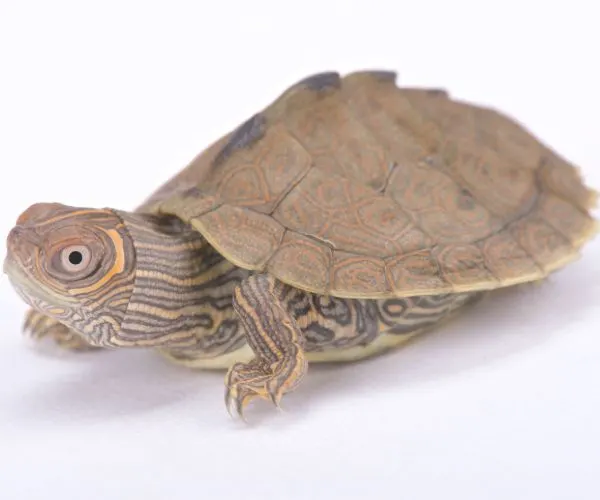
Quick Facts
- Experience Level: Beginner
- Family: Emydidae
- Scientific Name: Graptemys
- Common Map Turtle Species: Northern map turtle (Graptemys geographica), Ouachita map turtle(Graptemys ouachitensis), false map turtle (Graptemys ), Mississippi map turtle (Graptemys pseudogeographica pseudogeographica)
- Average Adult Size: 5 – 12 inches
- Lifespan: 20 – 40 years
- Average Price Range: $20 – $50
Quick Care Requirements
- Diet: Commercial aquatic turtle pellets, dark leafy green vegetables, insects
- UVB Lighting: Required
- Tank Size: 40 – 75 gallons
- Water Temperature: 70 – 85 °F
- Basking Spot Temperature: 90 – 95°F
Map turtles are among the most popular small turtle breeds kept as pets. This is because they are hardy strong swimmers that are easy to care for. Since they are quite commonly bred, map turtles are easy to find.
In all, 13 species make up the genus map turtle, scientifically called Graptemys. The most common map turtle species include northern map turtle, black knobbed map turtle, false map turtle, Barbour’s map turtle, and Mississippi map turtle.
Map turtles are known as map turtles because of the contour-like patterns found on their carapace, limbs, and head. They are also known as sawback because of the distinctive keel that runs the length of their carapace.
Map turtles accept commercial turtle diets. Supplement this with leafy greens high in fiber and calcium, and insects. Map turtles require basking spots, UV lighting, and an aquarium heater in case water temperatures are too low.
These lively turtles don’t like to be held but will rush enthusiastically towards their keepers once they get used to them. Map turtles can cohabitate peacefully with other North American small turtles.
3. Painted Turtle
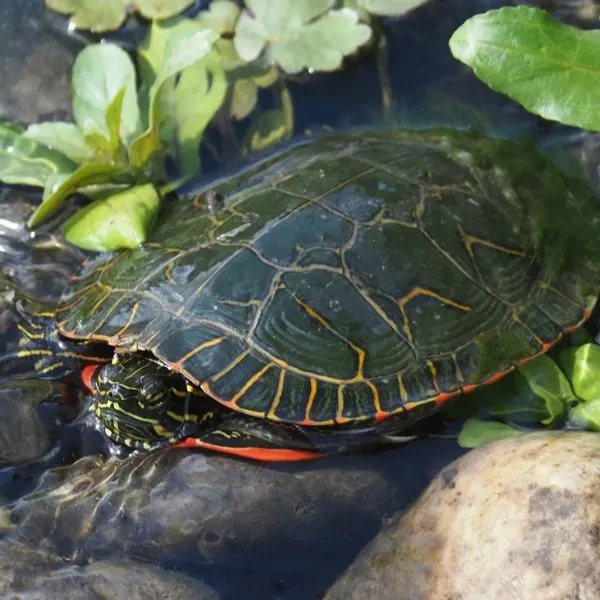
Quick Facts
- Experience Level: Beginner
- Family: Emydidae
- Scientific Name: Chrysemys picta
- Subspecies: Eastern painted turtle (C. p. picta), midland painted turtle (C. p. marginata), southern painted turtle (C. p. dorsalis), and western painted turtle (C. p. bellii)
- Average Adult Size: 5 – 8 inches
- Lifespan: 30 – 40 years
- Average Price Range: $20 – $40
Quick Care Requirements
- Diet: Commercial aquatic turtle food, leafy greens, insects
- UVB Lighting: Required
- Tank Size: 40 – 75 gallons
- Water Temperature: 70 – 80 °F
- Basking Spot Temperature: 90 – 95°F
Painted turtles are very attractive turtles found in North America. The colorful marking on their body makes them one of the most attractive pond turtles in the world.
These widespread turtles are easily recognized by the vivid coloration on their body. There are four subspecies of the painted turtle. These have already been listed above. The most popular one among them is the western painted turtle.
The largest of the painted turtles, which is the western painted turtle, rarely grows beyond 8 inches.
Eastern painted turtles and midland painted turtles rarely outgrow 7 inches.
The southern painted turtle rarely grows beyond 6 inches. As you can see, these are small turtles. Their small and colorful nature has made them one of the most popular miniature pet turtles.
Although painted turtles can live up to be 50 years, a well-kept painted turtle generally lives to be 30 years.
What do these small turtles eat? You can feed painted turtles commercially produced aquatic turtle food. They enjoy it and it provides all the needed nutrients.
In addition to this also feed them leafy greens such as romaine lettuce, dandelion green, and fresh parsley. They also accept aquatic plants such as water lettuce and water hyacinth.
Painted turtles require UVB light, a heat lamp, and a basking spot. The aquarium should be large enough to accommodate the turtle easily. A 40-gallon aquarium should be large enough for a single male.
Painted turtles cohabitate peacefully with other members of their species as well as other small aquatic turtles.
If you plan on housing several turtles make sure the aquarium is large enough. Although painted turtles are quite sociable, they don’t appreciate human handling.
Learn more about Painted Turtles here.
4. Musk Turtle
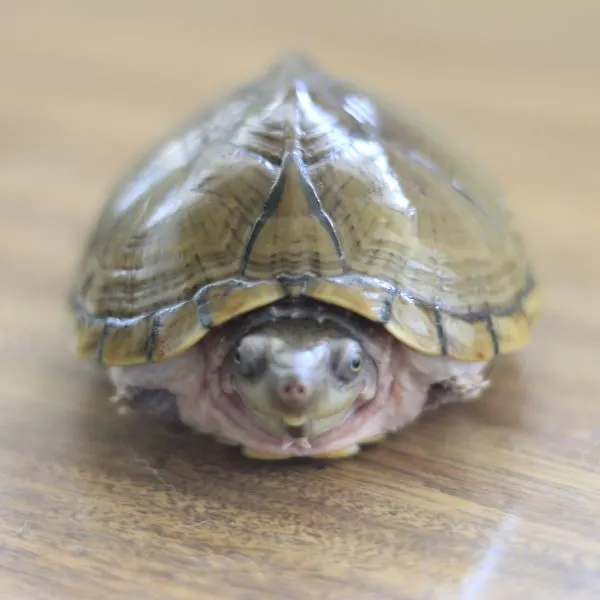
Quick Facts
- Experience Level: Intermediate
- Family: Kinosternidae
- Scientific Name: Sternotherus
- Common Subspecies: Flattened musk turtle (Sternotherus depressus), loggerhead musk turtle (Sternotherus minor), razor-backed musk turtle (Sternotherus carinatus), and common musk turtle (Sternotherus odoratus)
- Average Adult Size: 3 – 5 inches
- Lifespan: 30 – 50 years
- Average Price Range: $5 – $50
Quick Care Requirements
- Diet: Commercial aquatic turtle food
- UVB Lighting: Required
- Tank Size: 25 – 40 gallons
- Water Temperature: 75 – 80°F
- Basking Spot Temperature: 90 F
Musk turtles are very similar to mud turtles, not only in appearance but also in nature. As such their needs are almost identical. It comes as no surprise that both turtles belong to the same family.
Musk turtles are like baby turtles that stay small. They have a brownish tan and a distinctive keel down the center of their carapace. These small turtles grow to just 3 to 5 inches in length.
The small musk turtle needs a modest tank to thrive. While it is necessary to provide a basking platform and a heat lamp, musk turtles hardly ever bask.
As with other aquatic turtles, musk turtles tend to be mostly carnivorous, although they accept plant food such as duckweed.
Feed them commercially produced turtle food such as Zoo Med Natural Aquatic Turtle Food (Hatchling Formula) and Tetra Reptomin Floating Food Sticks. Supplement this with shrimp, trout chow, bloodworms, and mealworms.
Musk turtles are feisty and may try to bite you when handled. As such, they need to be handled with care. Common musk turtles, also known as the stinkpot, will emit a foul smell when feeling scared or threatened.
Learn more about Musk Turtles here.
5. Mud Turtle
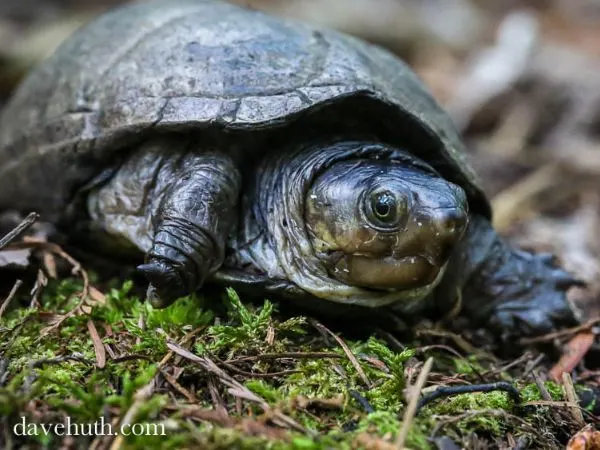
Quick Facts
- Experience Level: Intermediate
- Family: Kinosternidae
- Scientific Name: Kinosternon
- Common Mud Turtle Species: Common mud turtle or eastern mud turtle (Kinosternon subrubrum), Mississippi mud turtle (Kinosternon subrubrum hippocrepis), striped mud turtle (Kinosternon baurii), and yellow mud turtle (Kinosternon flavescens)
- Average Adult Size: 3 – 5 inches
- Lifespan: 30 – 50 years
- Average Price Range: $6 – $40
Quick Care Requirements
- Diet: Aquatic turtle food
- UVB Lighting: Required
- Tank Size: 25 – 40 gallons
- Water Temperature: 75 – 80°F
- Basking Spot Temperature: 90 F
Mud turtles are so-called because they prefer to live in small ponds with muddy bottoms. Mud turtles are very similar in appearance to musk turtles but unlike musk turtles, mud turtles have flatter carapaces.
This dwarf turtle grows from 3 to 5 inches, and as such, doesn’t need a large tank. They are one of the smallest turtle species in the world.
Although mud turtles don’t bask much, you still need to provide a basking platform and a basking lamp. The temperature of their water should be between 70 and 80 degrees.
Ensure the water temperature doesn’t fall below 70 degrees. The basking spot temperature should be high enough to encourage basking just in case.
Mud turtles are generally considered as carnivores. In the wild, they feed on mollusks, crustaceans, worms, fish, and amphibians. They generally feed on any animal smaller than they are.
Offer hatchlings hatchling formula if you can.
Offer adults commercial turtle food and some leafy greens if they accept them. You can feed them shrimp, krills crickets, mealworms, feeder fish, tilapia, chicken, and other animal products.
Mud turtles are more prone to biting as well.
You can find these small turtles for sale at sites like myturtlestore.com.
6. Diamondback Terrapin
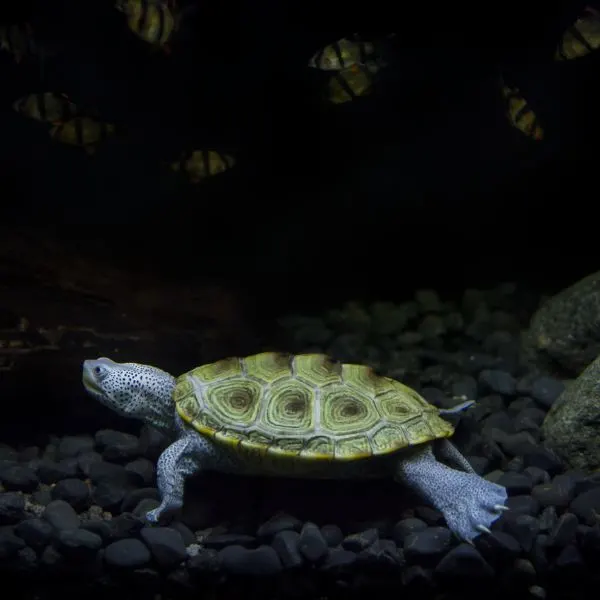
Quick Facts
- Experience Level: Intermediate
- Family: Emydidae
- Scientific Name: Malaclemys terrapin
- Other Common Names: Terrapin
- Average Adult Size: 5 – 7 inches
- Lifespan: 30 years
- Average Price Range: $250 – $400
Quick Care Requirements
- Diet: Commercial turtle diets
- UVB Lighting: Required
- Tank Size: 40 gallons
- Water Temperature: 76 – 78 F
- Basking Spot Temperature: 85 – 90 F
Diamondback terrapins are gorgeous turtles well known for their ornate carapace which features diamond patterns. There are many different shell coloration available.
While coloration varies from greyish white all the way to brown. Unlike other pond turtles, terrains prefer to live in brackish and salty water as such they are well-adapted to nearshore marine ecosystems.
Because it has a protected status, you may need a permit to keep one as a pet depending on your state and locale. Before you adopt any terrapins as mini pet turtles, make sure that you go through the right channels.
In terms of care, the terrapin is relatively easy to care for. A 40 to 60-gallon tank should be large enough for an adult terrapin. The terrapin also needs a basking platform with temperatures in the mid-80s.
As with all other North American turtles, the terrapin needs exposure to UV light. Be sure to have a UVB lamp installed.
As predominantly carnivorous, feed the diamondback terrapin insects and fish such as shrimp, krills crickets, and mealworms. Avoid feeding them freshwater crayfish. Alternatively, you can feed them commercial turtle diets.
Wild diamondback terrapins tend not to thrive in captivity. It is best to acquire these wonderful specimens from reputable captive breeders.
Learn more about the Diamondback Terrapin here.
7. Box Turtle
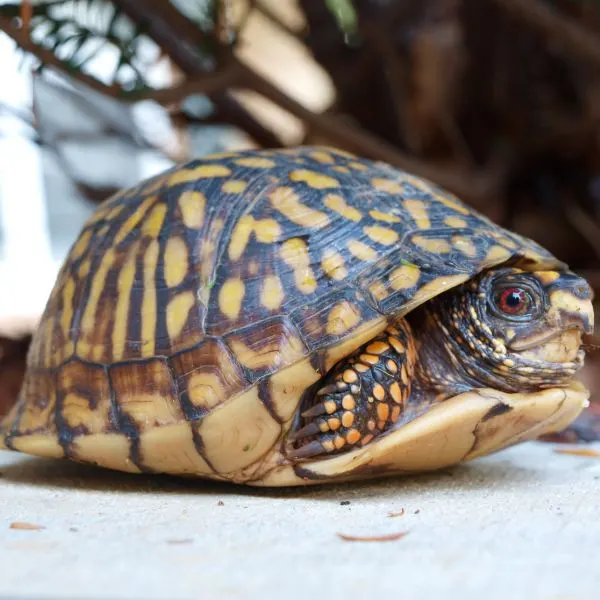
Quick Facts
- Experience Level: Beginner
- Family: Emydidae
- Scientific Name: Terrapene
- Common Box Turtle Species (& Subspecies): Eastern box turtle (Terrapene carolina), ornate box turtle (Terrapene ornata ornata), three-toed box turtle (Terrapene carolina triunguis), and the desert box turtle (Terrapene ornata luteola)
- Average Adult Size: 4 – 7 inches
- Lifespan: 40 years in captivity, 100 years in the wild
- Average Price Range: $120 – $400
Quick Care Requirements
- Diet: Commercial turtle food
- UVB Lighting: Required
- Terrarium Size: 20 gallons
- Temperature: 80°H/75°L
Box turtles belong to the genus Terrapene. And although box turtles are actually pond turtles, they are terrestrial. As land turtles, box turtles do not need an aquarium but rather a terrarium.
These are mini turtles that stay small. They can be housed in an outdoor enclosure during the summer and spring and indoors during the fall and winter. Box turtles resemble tiny tortoises.
They have high domes just like tortoises. There are several popular species kept as pets and these include eastern box turtle, ornate box turtle, and the desert box turtle.
As already mentioned, box turtles require a dry enclosure such as a wooden vivarium or a tortoise box. Make sure to always provide the turtle with water.
Box turtles accept leafy greens such as dandelion, clover, leafy salads, and curly kale and snails, crickets, and meat.
As with any other turtle, box turtles require UVB light. If housed outdoors, then sunlight will suffice otherwise install a UVB light in their enclosure.
In case you are wondering if box turtles can swim, the answer is yes, though not for a long time and not well.
8. Spotted Turtles
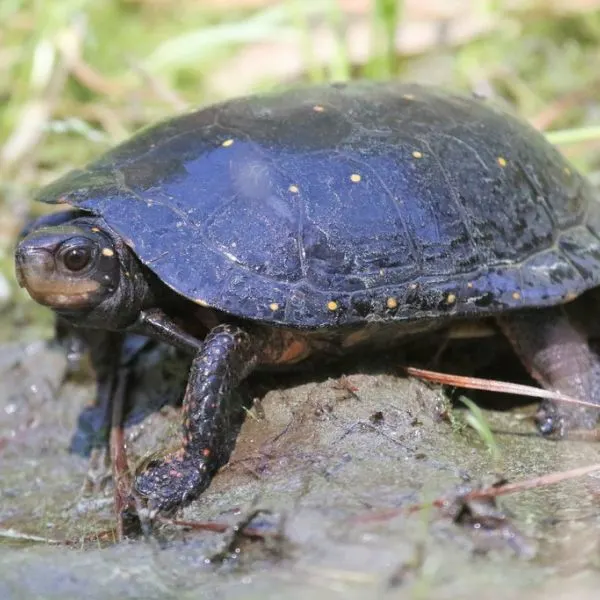
Quick Facts
- Experience Level: Beginner
- Family: Emydidae
- Scientific Name: Clemmys guttata
- Average Adult Size: 3 to 5 inches
- Lifespan: 26 to 50 years
- Average Price Range: $200 – $600
Quick Care Requirements
- Diet: Commercial turtle diets
- UVB Lighting: Required
- Tank Size: 40 gallons
- Water Temperature: 65 – 75 F
- Basking Spot Temperature: 88 – 90 F
Coming in at number 8 on our list of small pet turtles that stay small is the adorable spotted turtle! These little guys make fantastic pets for anyone interested in reptiles. If you’re trying to find for spotted turtles for sale, you’re in luck, because you can find them at theturtlesource.com.
It’s important to note that while spotted turtles are small, they require specific care to ensure they stay happy and healthy. That’s why we highly recommend checking out the in-depth care guide for spotted turtles at https://www.allturtles.com/spotted-turtle/. There, you’ll find all the information you need to provide the best possible care for your new pet.
So, if you’re looking for a small pet turtle that’s both cute and interesting, the spotted turtle is definitely worth considering! Just be sure to do your research and follow the care guide to ensure the best possible experience for both you and your new little friend.
Why You Should Choose Turtles That Stay Small
The turtles that stay small are not only cute as a button, but they also bring in several other benefits for turtle owners. Let’s dive into some of them.
They’re Affordable
Although small turtles don’t come very cheap, the overall cost of ownership is pretty low.
Unlike large turtles, they don’t need a large tank or even a high capacity filtration system. A small tank works just fine and is easy on the wallet. After the setup, the recurring costs that go towards the food, filters, and replacement parts are substantially lower.
They Don’t Take Much of Your Time
Because these turtles are small and take up less space, looking after them is also relatively easy. They’ll have minimum dirt and waste to clean, the filtration system will only need cleaning once in a while, and feeding needs will be less frequent.
Feeding Them Is Never a Hassle
Unlike many other pets (especially other reptiles and amphibians), feeding the turtles in the correct ratio will never be a problem. They eat pretty easily, and their appetite includes a wide range of foods.
While they do have a specialized diet plan, it’s advised not to venture out too much. They eat pretty much any standard food without much hassle.
Moreover, feeding them every 2 or 3 days is enough. They’re not known for their big appetites.
Why Getting Small Turtles from the Wild Isn’t a Good Idea
Although small turtles found in the wild may seem reasonable because they’re free to get, it’s never a good idea. Turtles sold near the beaches are generally illegal and were found in the wild, so try to avoid those. As they were born in the wild, keeping them in a small tank makes them nervous and aggressive.
That is why you should always opt for turtles born in captivity and bred by certified and well-known breeders. They’re generally calm, and their temperament is well adjusted in the small captive tank.
Other Small Turtle Species
This article lists seven small turtles that are apt for a small tank, but these aren’t the only ones. There are several other small turtle species that you can keep as a pet.
For example, the Reeve’s turtle (a Chinese pond turtle) is generally found in Asia. They’re also bred in captivity and can quickly adapt to it.
They’re not the smallest, with the larger ones growing as large as 9 inches. Their females are generally larger than males. These aren’t very good swimmers but need substantial water so that they can make themselves comfortable if they accidentally end up on their back.
They are on the larger side of the small turtles, so they need a bigger tank than most others. However, if you have a larger living space and need something bigger than the small-sized turtles mentioned above, consider going for this one.
FAQ’s
What is the smallest turtle in the world?
The Speckled padloper is the smallest turtle in the world, which is technically a tortoise. They are found in Namibia and Western South Africa.
How small is the smallest turtle?
The Speckled padloper grows to a maximum adult size of around 4 inches (10cm) with females being the larger of the genders. Male padlopers will reach around 3 inches (7.6cm) at full maturity.
What is the smallest aquatic turtle?
The smallest aquatic turtle is the musk and mud turtles. Both species grow to be between 3 (7.6cm) and 5 inches (12.7cm) in size as mature adults.
On the semi aquatic turtle side of things, the bog turtle qualifies as the smallest ranging from 3.5 (8.9cm) to 5 (12.7cm) inches in size. Bog turtles are not turtles that should be kept as pets though.
What is the smallest box turtle?
There are several box turtles that qualify as some of the smallest box turtles. The smallest box turtle is the Coahuilan Box Turtle ranging between 3 (7.6cm) and (15.2cm) 6 inches which is the only aquatic box turtle species. The runner ups are the Desert box turtle, Ornate box turtle, and Three-toed box turtle ranging from 4 (10.1cm) and 5 (12.7cm) inches.
What do small pet turtles eat?
Small turtles eat a variety of things including crickets, mealworms, leafy greens, commercial pellets and more. Diets will vary slightly depending on species. It’s a good idea to keep a feeding schedule to ensure they have a balanced diet. Vitamin supplements such as vitamin D3 should also be considered to ensure they stay healthy.
What turtle stays small forever?
Musk and mud turtles and the rest of the species on the list stay small forever (for their lifetime). The mud and Musk turtle are the smallest on this list that make great freshwater pet turtles.
How long do small turtles live?
Small turtles live between 20 and 50 years. This varies widely based on species, but many factors come down to the quality of care provided by the turtle keeper. Care is key for keeping turtles healthy and happy for the long term.
Where can i buy a small turtle?
Small turtles are for sale online and can be bought from sites like Xyzreptiles.com, theturtlesource.com, other online retailers and your local pet store. They will have captive bred baby turtles for sale, so you don’t need to worry about them being wild caught, though you should always check before buying. This means the turtles are bred and not taken out of the wild.
Wild turtles do not make good pets for a number of reasons, including habitat destruction, possible parasites, and the turtles happines. Just think how you would feel if someone locked you up in a cage after knowing what freedom felt like.
What is the best small turtle for beginners?
The best small turtle for a begginner is going to be between the musk turtle and a box turtle. Musk turtles require an aquatic setup, while box turtles need a terrestrial setup since they do not swim.
I recommend checking our page about what turtles cost.
This will give you the full overview about initial costs and ongoing costs of owning these types of small turtle species as well as tortoise species.
Conclusion
Small turtles are the best, not only are they great pets, but they also occupy little space. This means cleaning after them simple and quick. Even if you don’t want to maintain an aquarium, land turtles such as the common box turtle are an excellent choice.
Acquiring pet turtles that stay small has its benefits. Regardless of the species you choose to adopt, be sure to only buy from reputable captive breeders.
And while turtles may not be as demanding as other pets, they need attention and love. Only adopt a turtle if you are sure that you can provide the care needed.
Let us know which small turtle is your favorite in the comments below! We love hearing from you!

Ellen White
Friday 22nd of May 2020
I have a small aquatic turtle. My tank had a leak and I had to find a tank fast. The one tank has a dry place for him to rest but the new tank I ordered something and it may take a few weeks to get to me. My question is can I put him in the tank without water due to leak at night and in the deep tank where he can swim during the day? How often should I let him swim without an above water resting place? A I right to think I need to move him back and forth from each tank? The tank that is damages has enough water for him to wet his feet but that is it.